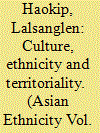| Srl | Item |
| 1 |
ID:
158094


|
|
|
|
|
| Summary/Abstract |
Creative literature and audio-visuals provide alternative sources to archival documents for understanding the cultural history of land. This paper is a small beginning in using creative sources in different languages of Manipur. My analysis suggests that the association between land and ethnicity is a recent phenomenon. In the late 1950s and the 1960s, creative artists represented land as aesthetic symbol for universal emotions. In the 1970s, land was de-linked from political imagination and appeared in the form of leikai (residential address). The 1980s registered the emergence of complex social forces such as ethnic nationalism and a romanticised folk culture. The most remarkable development was the exclusive use of land as a symbol of discrete identities and ethnic homelands. Whereas the ethnic gulf widened between the meiteis of the valley and the tribals of the hill areas, the struggle between the hill tribes intensified in the 1990s.
|
|
|
|
|
|
|
|
|
|
|
|
|
|
|
|
| 2 |
ID:
151565


|
|
|
|
|
| Summary/Abstract |
Around the world, music serves as an important element of mobilisation for social movements. Singing songs is not only a peaceful protest technique but also helps to construct a protest identity locating and relating the social movement to its political and social environment. Most importantly, a social movement is to a significant extent remembered through its music, and this determines its future impact on local (contentious) politics. Against this backdrop, this article seeks to understand Hong Kong’s Umbrella Movement through four YouTube music videos, analysing the lyrics, music, and video imagery in order to carve out core elements and values of the Umbrella Movement. Especially given the importance of Hong Kong’s identity as a “global” city with a cosmopolitan culture and past, the peaceful nature of the movement and the rise of a xenophobic localism in the shape of sarcasm are emphasised.
|
|
|
|
|
|
|
|
|
|
|
|
|
|
|
|
| 3 |
ID:
110218


|
|
|
|
|
| Publication |
2011.
|
| Summary/Abstract |
Vietnamese music history records the song 'Cùng nhau di hông binh' ['Let's Go Forward Red Army'] as having been created at the time of the Nghe Tinh Soviet and the founding of the Indochinese Communist Party. Attributed to a political prisoner, it circulated in Vietnam's prisons in the 1930s. Although the circumstances of the song's creation and creator are murky, both have been given revolutionary credentials to help solidify claims that the Communist Party guided a Vietnamese musical renaissance.
|
|
|
|
|
|
|
|
|
|
|
|
|
|
|
|
| 4 |
ID:
172221


|
|
|
|
|
| Summary/Abstract |
We have heard and read much about the wartime bravery of Gurkha soldiers, the idea of the Gurkhas as a martial race and how British recruitment practices targeted them. But much less is known about the experiences of Gurkha prisoners of war in World War I. The Germans captured thousands of soldiers fighting in the British Indian Army, and among these were a large number of Gurkhas. This imprisonment of soldiers not only served German strategic goals, but also offered a good opportunity to collect source material for research. This paper will briefly shed light on the scholarly activities engaged in by German scholars in Halbmondlager (Half Moon Camp), with a focus on the self-referential writing of one of the Gurkha prisoners of war, Jas Bahadur Rai, who never returned from the camp, but who did bequeath to posterity a song which he sang for the Germans. We will discuss whether Jas Bahadur had freedom of agency while recording his song, and if this song indeed qualifies as life-writing.
|
|
|
|
|
|
|
|
|
|
|
|
|
|
|
|